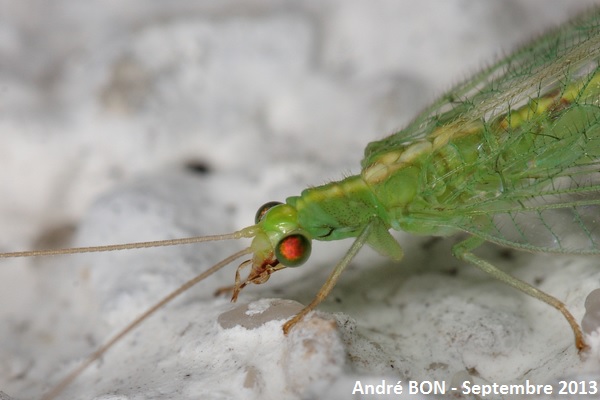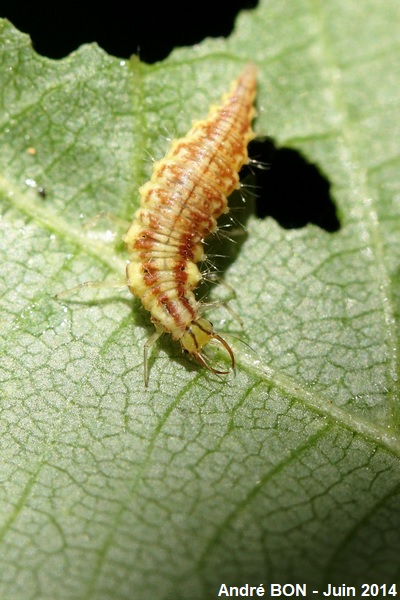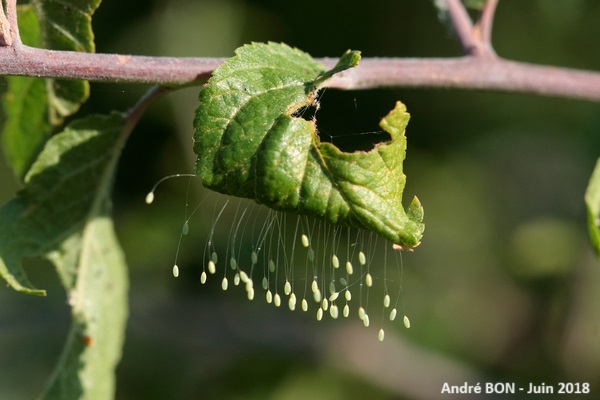





| Common Green Lacewing (Chrysoperla carnea (Stephens, 1836)) |






|
|
Scientific name: Chrysoperla carnea (Stephens, 1836) Common name: Common Green Lacewing French name: Chrysope verte, Demoiselle aux yeux d'or. Order: Neuroptera Family: Chrysopidae Wingspan : Body size: 10 to 15 mm; Wingspan: 23 to 30 mm. Biotope: Meadows, cultivated fields, woodland edges, forests, hedgerows, parks and gardens. In the litter or inside human buildings in winter. Geographic area: Worldwide spread except in Australia for the group of species initially listed within the Chrysoperla carnea complex. Observation period : May to September outside. |
The Neuroptera of the Chrysopidae family show hyaline spotless wings. The cross veins of the costal area are not forked. The general colour is often green and sometimes pale brown or yellow. The green species, with a thin yellow dorsal stripe sometimes marked with reddish on each segment, with translucent membranous wings crossed by green veins, with long thread-like antennae and initially listed as Chrysoperla carnea belong in fact to a complex of several similar species (about twenty). It is very difficult to tell these species apart. The criteria to identify species among the group are mainly based on the analysis of their low frequency songs produced by the vibration of the abdomens of males and females before mating. These courtship songs are typical for a given species. This is complemented by DNA tests and small morphological differences that are difficult to see. Here is some information that I have found here and there and that we must consider with some reserve as there is still work in progress and the different entomologists do not all agree. The Chrysoperla carnea group includes three species in France, Chrysoperla carnea, Chrysoperla lucasina and Chrysoperla kolthoffi. Chrysoperla carnea is found anywhere in France but in low numbers and rather high in trees. Chrysoperla lucasina is found in the Mediterranean region (I have found records in Luxemburg and Belgium …) and rather among grasses. Chrysoperla kolthoffi also listed as Chrysoperla affinis is mainly found in the northern and western regions and rather among grasses. The eggs are attached to vegetation at the tip of a long and thin peduncle. The larvae of lacewings of the Chrysoperla genus feed on aphids, adults feed on pollen, nectar and aphid honeydew. Lacewings of the Chrysoperla genus overwinter at the adult stage and their colour turns to pinkish, yellowish or reddish brown. |
| [To know more about the Common Green Lacewing] [Next picture] [Top] |

|
Based on all I have read I think that it is impossible to go further than Chrysoperla of the carnea group. Does this observation on the wall of the house mean that this lacewing wanted to enter to overwinter? |
| [To know more about the Common Green Lacewing] [Next picture] [Previous picture] [Top] |

|
Upper side view. |
| [To know more about the Common Green Lacewing] [Next picture] [Previous picture] [Top] |

|
Close-up view. |
| [To know more about the Common Green Lacewing] [Next picture] [Previous picture] [Top] |

|
Here is one larva of the Chrysoperla genus with its large falciform mandibles. It is a great predator of aphids. |
| [To know more about the Common Green Lacewing] [Next picture] [Previous picture] [Top] |

|
Here are the characteristic eggs of members of the Chrysopidae family. They are attached to the tip of a long, thin peduncle. |
| [To know more about the Common Green Lacewing] [Previous picture] [Top] |

|
I found this Lacewing inside the house. Did it overwinter there? I think it's more likely that it just came in, attracted to light. |